Highlights of Plant Science 2017
During the final week of 2017 we reminded you of some of the big stories and successes that came from our community. These stories were highly accessed through the ASPB and Plantae.org blogs, our many social media sites, and our journal websites. Originally publised as a set of six posts, we’ve assembled the full year’s worth of highlights in one article. We hope you enjoyed this look back at what was an eventful and productive year in plant science. Special thanks to Megan Lynch for providing several in-depth spotlights for this series!
January – February
Spotlight: Once again, one of the biggest stories of 2017 has been how the genome-editing power of CRISPR/Cas9 is revolutionizing both basic and applied plant science. If you’re not familiar with CRISPR, you can find a nice, accessible overview in C&EN by Bomgardner, “CRISPR: A new toolbox for better crops”.
Throughout the year we’ve seen powerful applications of this precision technology, from the production of parthenocarpic tomatoes (which form fruit without requiring pollination) by Ueta et al., accelerating the domestication of new crops (Østerberg et al.) to the generation of targeted or untargeted diversity for analysis and selection, including a big improvement in tomato yield through editing a few key genes (Rodríguez-Leal et al.). CRISPR is also being employed for disease resistance: see Bart and Taylor for a nice discussion of its use in the development of disease-resistant cassava. See also reviews by : Puchta, Zhu et al., Čermák et al., Arora and Narula, and Volpi e Silva and Patron. Improvements in the CRISPR methods include the use of the Cpf1 nuclease (Begemann et al.), the finding that heat-treatment enhances CRISPR editing efficiency (LeBlanc et al.) and RNA editing with CRISPR-Cas13 (Cox et al.).
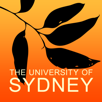 Our top blog post in January was guest-written by Rosanne Quinelle, Associate Professor in the School of Life and Environmental Science at the University of Sydney, Australia (@ah_cue). Roseanne wrote about BotanyOnline, a collection of online resources for learning about botany, which includes an interactive, dichotomous key to all species of vascular plants in the Sydney Region and a Campus Flora app. Be sure to check out the Virtual Slides, very high resolution scanned micrographs of plant sections. They are irresistible!
Our top blog post in January was guest-written by Rosanne Quinelle, Associate Professor in the School of Life and Environmental Science at the University of Sydney, Australia (@ah_cue). Roseanne wrote about BotanyOnline, a collection of online resources for learning about botany, which includes an interactive, dichotomous key to all species of vascular plants in the Sydney Region and a Campus Flora app. Be sure to check out the Virtual Slides, very high resolution scanned micrographs of plant sections. They are irresistible!
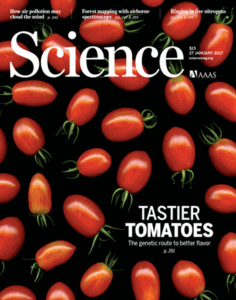 Spotlight: Tieman, Zou et al. from Harry Klee’s group at the University of Florida reported on a Chemical genetic roadmap to improve tomato flavor, which was featured on the cover of Science. The study combined several approaches including chemical and genomic analyses along with consumer tasting panels, and identified several loci associated with tasty tomatoes. (See below to see how this article made headlines again in April).
Spotlight: Tieman, Zou et al. from Harry Klee’s group at the University of Florida reported on a Chemical genetic roadmap to improve tomato flavor, which was featured on the cover of Science. The study combined several approaches including chemical and genomic analyses along with consumer tasting panels, and identified several loci associated with tasty tomatoes. (See below to see how this article made headlines again in April).
Genome sequences of two plants topped our most-read lists in February:
Cephalotus follicularis is a carnivorous Australian pitcher plant. Genomic and transcriptomic analysis revealed that although carnivory evolved independently multiple times, similar genes are involved in diverse species. The article that generated the news is by Fukushima et al., and some of the press includes a Nature News article and a story on NPR.
The other big genome story in February was that of quinoa, Chenopodium quinoa (see Jarvis et al.) Quinoa is a salt-tolerant plant that produces a gluten-free grain, and has widely been described as a “superfood”. The quinoa genome was covered in Popular Science, The Christian Science Monitor, BBC, and many other news outlets.
March – April
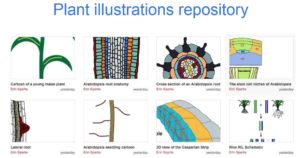
Our top blog post in March was the announcement of “A community repository of plant illustrations,” a guest blog post by Erin Sparks, Guillaume Lobet, Larry York and Frédéric Bouché. Need a plant image? Check out the repository to find one you can use. Have an image to share? It’s easy to contribute! And what could be nicer and more community-spirited than sharing the images you’ve created?
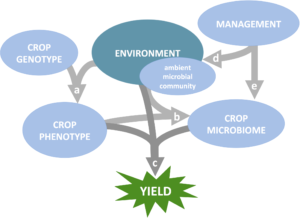 Another top post in March was a Nature News Feature by Brooke Borel, “CRISPR, microbes and more are joining the war against crop killers”; a must read to see what is on the horizon of agricultural biotechnology. Speaking of microbes, the good kind were the topic of the interesting Perspective by Busby et al. on “Research priorities for harnessing plant microbiomes in sustainable agriculture,” another must-read to learn how crop production can be enhanced through leveraging beneficial biotic interactions.
Another top post in March was a Nature News Feature by Brooke Borel, “CRISPR, microbes and more are joining the war against crop killers”; a must read to see what is on the horizon of agricultural biotechnology. Speaking of microbes, the good kind were the topic of the interesting Perspective by Busby et al. on “Research priorities for harnessing plant microbiomes in sustainable agriculture,” another must-read to learn how crop production can be enhanced through leveraging beneficial biotic interactions.
A few of the most-shared and most-viewed research articles during these months included a study by Wang et al. that aligned ten legume genomes to establish a family-level genomics platform, which should greatly facilitate breeding improvement efforts for these important crop plants. In a separate study, Dietrich et al. identified the role of the root cortex in root hydrotropism (growth toward water). For those who love evo-devo (me!), from a study of a pre-lignin pathway in moss by Renault et al. we got a fascinating glimpse into the evolutionary precursors of lignin, which made big plants possible.
Spotlight: Oldest plant fossil
 Another big story of the year concerned a paper by Bengston et al., who identified 1.6 billion-year old fossils of multicellular plants, much older than previously identified. Press coverage included the BBC, who wrote about the Oldest Plant on Earth. Reddit hosted an “ask me anything” with first author Stefan Bengston (which is a great way to make science relevant to the broader public!).
Another big story of the year concerned a paper by Bengston et al., who identified 1.6 billion-year old fossils of multicellular plants, much older than previously identified. Press coverage included the BBC, who wrote about the Oldest Plant on Earth. Reddit hosted an “ask me anything” with first author Stefan Bengston (which is a great way to make science relevant to the broader public!).
In April, Nature published a special supplement on Food Security, including an overview of the role of technology in agriculture. Also in April, a report by Schon and Nodine in The Plant Cell showed widespread contamination by other tissues in Arabidopsis embryo and endosperm transcriptome databases, alerting researchers to the need to conduct rigorous testing of their data.
 Now, back to those tasty tomatoes…. April also saw the curious case of Kevin Folta vs Senator Rand Paul vs tomato (no fooling). In his regular “Waste Report” in which he points out things he considers to be wasteful government spending, Sen. Paul criticized NSF funding of the tomato flavor improvement project that was the cover story in Science in January. As well as being Chair of the Horticultural Science Department at the University of Florida (where the tomato work was done), Kevin Folta is also a dedicated science communicator, who defended the NSF-funded research project in a widely-read reply in the Huffington Post, “Senator Paul, make tomatoes great again.”
Now, back to those tasty tomatoes…. April also saw the curious case of Kevin Folta vs Senator Rand Paul vs tomato (no fooling). In his regular “Waste Report” in which he points out things he considers to be wasteful government spending, Sen. Paul criticized NSF funding of the tomato flavor improvement project that was the cover story in Science in January. As well as being Chair of the Horticultural Science Department at the University of Florida (where the tomato work was done), Kevin Folta is also a dedicated science communicator, who defended the NSF-funded research project in a widely-read reply in the Huffington Post, “Senator Paul, make tomatoes great again.”
Spotlight: Botanic Gardens Conservation International (BGCI) assembles a list of tree species (By Megan Lynch*)
 BGCI consulted both published material and the resources of its member organizations to quantify the number of tree species, which it reckons to be 60,065. Two years in the making, this is a step in the Global Tree Assessment, which aims to provide conservation status of all Earth’s tree species by 2020. The database will allow those working on conservation to look up information taxonomically and also by country in a tree species’ native range. Check out the BBC coverage, read the article by Beech et al. and check out the database at http://www.bgci.org/global_tree_search.php.
BGCI consulted both published material and the resources of its member organizations to quantify the number of tree species, which it reckons to be 60,065. Two years in the making, this is a step in the Global Tree Assessment, which aims to provide conservation status of all Earth’s tree species by 2020. The database will allow those working on conservation to look up information taxonomically and also by country in a tree species’ native range. Check out the BBC coverage, read the article by Beech et al. and check out the database at http://www.bgci.org/global_tree_search.php.
May – June
One of the biggest stories in May concerned a pair of papers coming from the lab of Xinnian Dong (Xu et al. and Xu et al.), which are nicely summarized nicely in a News from Science article, “Rice plant engineered with a ‘tunable’ immune system could fight multiple diseases at once.” The TL;DR (“too long, didn’t read”) version is that the authors introduced a translational regulatory sequence into key defense regulators, producing plants that rapidly and transiently respond to pathogens without incurring a growth-penalty. In other words, the growth-defense trade-off (in which activating defense pathways slows growth and lowers yields) could one day be a thing of the past. Given that rice is one of the most important food crops globally, these results are very exciting.
The Camellia sinensis (tea) genome presented by Xie et al. was another top story, because life would be so much poorer without a nice cuppa.
Three new papers published in June (Luginbuehl et al., Keymer et al., and Jiang et al.) showed that plants provide fats as well as sweets to their mycorrhizal fungal partners. (If you’re looking for an interesting exercise for your students, have them compare and contrast the methods used and findings of these three papers. How did the different teams explore this inter-kingdom metabolic exchange?).
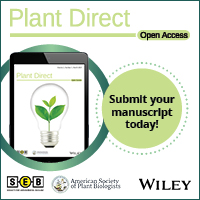 June saw the launch of the latest plant journal, Plant Direct Journal, which is an open-access, sound-science, society-published journal that supports both ASPB and SEB. Read more about Plant Direct in an editorial by Editor-in-Chief Ivan Baxter http://onlinelibrary.wiley.com/doi/10.1002/pld3.1/abstract, and follow Plant Direct on Twitter to keep up with the latest papers @PlantDirectJ.
June saw the launch of the latest plant journal, Plant Direct Journal, which is an open-access, sound-science, society-published journal that supports both ASPB and SEB. Read more about Plant Direct in an editorial by Editor-in-Chief Ivan Baxter http://onlinelibrary.wiley.com/doi/10.1002/pld3.1/abstract, and follow Plant Direct on Twitter to keep up with the latest papers @PlantDirectJ.
Spotlight: Kew issues second “State of the World’s Plants” report (By Megan Lynch*)
 The Royal Botanic Gardens at Kew made a splash in 2016 when they assembled a large international team of plant scientists and released their report, State of the World’s Plants. They’ve kept the ball rolling this year with the release of the second of what will be annual reports. Last year’s report focused on counting – basic quantification of plants in a number of categories, including how many are threatened species. The second report expands and refines, including trying to get at why some plants seem more vulnerable to extinction threats than others. 2016’s report inaugurated a country focus for the report, Brazil. The 2017 report highlights Madagascar, many of whose species are endemic.
The Royal Botanic Gardens at Kew made a splash in 2016 when they assembled a large international team of plant scientists and released their report, State of the World’s Plants. They’ve kept the ball rolling this year with the release of the second of what will be annual reports. Last year’s report focused on counting – basic quantification of plants in a number of categories, including how many are threatened species. The second report expands and refines, including trying to get at why some plants seem more vulnerable to extinction threats than others. 2016’s report inaugurated a country focus for the report, Brazil. The 2017 report highlights Madagascar, many of whose species are endemic.
Reading some of the statistics that came out of their research, an initial snapshot that is bound to come into better focus with further field expeditions and herbarium research, it was impressed upon me anew that while the public imagination is captured by space exploration, humans have not even fully explored our own planet.
Given the effects of climate change, time is of the essence. Not just to find out how to adapt and cope with it, but to document and cultivate species that won’t be able to cope with the emerging climate patterns. The scale and speed with which this can be done depends on funding, so it’s crucial to communicate not just the urgency of the problem, but why the average citizen should be concerned about it. 2016’s report had a section on economic botany and 2017’s hones the economic botany focus to medicinal plants, only a fraction of which are currently being put to use. Even people who can’t connect with a nebulous idea of biodiversity can understand that there could be undiscovered cures for diseases in habitats that need to be protected.
Part of engaging the public is not just accessible language, but appealing and intriguing graphic design. Kew delivers this in both a dedicated website and a sumptuous downloadable report, https://stateoftheworldsplants.com/. They also installed a “State of the World’s Plants” set of exhibits that could be seen by visitors to the RHS Chelsea Flower Show as well as at Kew itself.
Today we’re celebrating the opening of our State of the World’s Plants exhibit at #RHSChelsea #SOTWP pic.twitter.com/ozpTWfot9I
— Kew Gardens (@kewgardens) May 22, 2017
July – August
A suite of pigment papers kept us busy and got lots of coverage in the media in July and August, from the true-blue chrysanthemum (Noda et al.) and blue rice endosperm (Zhu et al.) to the antimicrobial properties of betalains (Polturak et al.). Read more about this colorful research.
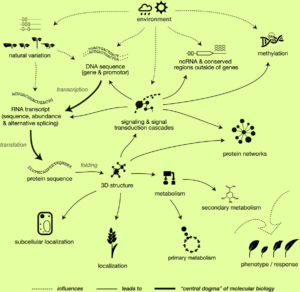 In other research news, Waese et al. introduced ePlant: Visualizing and Exploring Multiple Levels of Data for Hypothesis Generation in Plant Biology. This database (http://bar.utoronto.ca/eplant) integrates genome, proteome, interactome, transcriptome, and 3D molecular structure data. It’s your source for everything you need to know about your favorite Arabidopsis gene or protein, and the code can be used for other species.
In other research news, Waese et al. introduced ePlant: Visualizing and Exploring Multiple Levels of Data for Hypothesis Generation in Plant Biology. This database (http://bar.utoronto.ca/eplant) integrates genome, proteome, interactome, transcriptome, and 3D molecular structure data. It’s your source for everything you need to know about your favorite Arabidopsis gene or protein, and the code can be used for other species.
Other hot papers included Taniguchi et al. who wrote about how the Arabidopsis LAZY1 family contributes to gravity signaling, and Pini et al. who presented a method for using bacterial biosensors for in vivo spatiotemporal mapping of root secretion; at last we can eavesdrop on the conversation between plants and their partners. A Policy Forum by Reynolds et al. addressed how best to integrate crop research for future breeding efforts, in the form of a Global Crop Improvement Network.
July and August saw a flurry of multimedia excitement, including the launch of the Taproot podcast, “a new podcast that digs beneath the surface to understand how plant science publications are created,” with hosts Liz Haswell and Ivan Baxter. If you missed it, you can still download all of the Season 1 episodes. Keep your ears open in early 2018 for the launch of Season 2!
We also saw some wonderful videos released. Molly Edwards is a graduate student at Harvard who in her spare time creates high-quality YouTube videos about plant science (she has also received support from ASPB through a BLOOME award). Check out her YouTube channel, and a Plantae seminar in which she describes the big picture and small details about how she produces these videos. In August she released a video (embedded below) in which she interviews scientists at the Van Eck Lab at the Boyce Thompson Institute to learn how genetically-modified plants are made.
August also saw the release of a beautifully animated video, part of the TED-Ed series, on how plants defend themselves.
September – October
Our top blog post in September, “I don’t know how she does it,” explored the challenge of balancing career and parenthood, particularly as it impacts women’s careers. Several women who “have it all” shared their strategies for success, with the hope of passing on the colleted wisdom to future generations. It’s an inspiring and touching set of essays which you won’t want to miss.
You know you’ve made it when Ed Yong writes about your research, so cheers to Moyroud, Wenzel et al. and the rest of team Glover for the terrific write up in The Atlantic, “Flowers Have Secret Blue Halos That Bumblebees Can See.” Pigments made the news again, with the evolutionary history of betalaine biosynthesis (Lopez-Nieves et al) garnering write-ups in the New York Times in two languages (How beets became beet red and Por qué el betabel se volvió rojo escarlata).
A few other stories that saw lots of social media shares:
 The ongoing challenges of banana pathogens got an excellent write-up in the Washington Post in Bananapocalypse: The race to save the world’s most popular fruit.
The ongoing challenges of banana pathogens got an excellent write-up in the Washington Post in Bananapocalypse: The race to save the world’s most popular fruit.- Mounce et al. explored how botanic gardens support plant diversity conservation, concluding that improvements could be made in the representation of tropical and especially non-vascular species.
- Because plant genomes can be highly repetitive, assembling them from short-reads can be extremely difficult. Long-read technology such as that developed by Nanopore can greatly facilitate genome assembly, and it can also be cost-effective, as demonstrated by Schmidt et al. in De Novo Assembly of a New Solanum pennellii Accession Using Nanopore Sequencing.
- I’m not sure this 100% counts as plant science, but there was a lot of interest in a story on NPR featuring a new book “Flora of Middle Earth: Plants of J.R.R. Tokein’s Legendarium.” Anything to combat plant blindness, right? Hopefully it will inspire interest in the Flora of Earth-Earth too.
Another highly shared post was a beautiful article in National Geographic Magazine: “Netherlands – this tiny country feeds the world”. As you might expect, the photographs are stunning, but the article also features plant science research from Wageningen University & Research (WUR), including short videos of graduate students describing their research. If you missed this article the first time around, here is your chance to read about the amazing agricultural accomplishments that can be achieved when governments support research and entrepreneurship. And 2018 is a special year for WUR as it will be celebrating its 100th anniversary with a year-long celebration.
An article from The Plant Cell about natural variation of vitamin E levels got a lot of attention. This article, by et al., used a genome-wide association study (GWAS) to identify genetic loci that contribute to vitamin E accumulation in seed oils from maize. Because seed oils are a major source of vitamin E in humans, this study provides a great foundation for improving access to adequate vitamin E in the diet.
This year the ASPB journals have been developing new ways to support our authors, such as by working with them to produce short, accessible articles that summarize their work. We’ve trialed accessible abstract-like summarizes on our Plantae page (“In a Nutshells“) and beginning in 2018 we’ll be publishing these with Plant Cell articles. In September, we created a channel in Medium called “Plant Cell Extracts” to post selected research summaries written by our editorial team. Please follow and share our fledgling foray!
Spotlight: Small Team Pushes Bread Wheat Genome Assembly Forward (By Megan Lynch*)
Assembling a genome sequence takes a fantastic amount of computing power and numerous scientists working on analyzing the data and fitting together the puzzle pieces. As a result, full genome sequencing projects have heretofore been an international effort involving several large teams. The bread wheat genome poses steep challenges in that it is not only hexaploid, not only very large indeed, but it has many long repeating sequences that complicate efforts to match the pieces back together. 2012 saw the first published attempt to sequence the Triticum aestivum (bread wheat) genome. Large teams continued working on it, but in November a team of six scientists (Zimin et al.) solved these knotty problems before the consortium did. This could herald a new era of smaller, more nimble genome projects. Read more in this Nature News article.
November – December
The biggest news from the end of the year was the recognition of Joanne Chory, one of the world’s preeminent plant biologists, who was awarded a prestigious Breakthrough Prize in Life Sciences, “For discovering how plants optimize their growth, development, and cellular structure to transform sunlight into chemical energy.” Joanne is the first plant scientist to receive this award. To quote from the Salk Institute’s article, “Chory has spent more than 25 years deciphering the mechanisms that allow plants to achieve this flexibility in form, pioneering the use of molecular genetics to study how plants respond to their environments and producing major discoveries surrounding how plants sense light and make growth hormones.” Not content to rest on their laurels, Dr. Chory and colleagues at the Salk Institute are launching a new initiative to harness the power of plants to combat climate change by sequestering more carbon as suberin in their roots – read more here.
Speaking of Arabidopsis, our friends at TAIR (The Arabidopsis Information Resource: https://www.arabidopsis.org/) shared a list of the 20 most studied genes (by citations) in Arabidopsis. Read about the individual genes and how the the list was curated here.
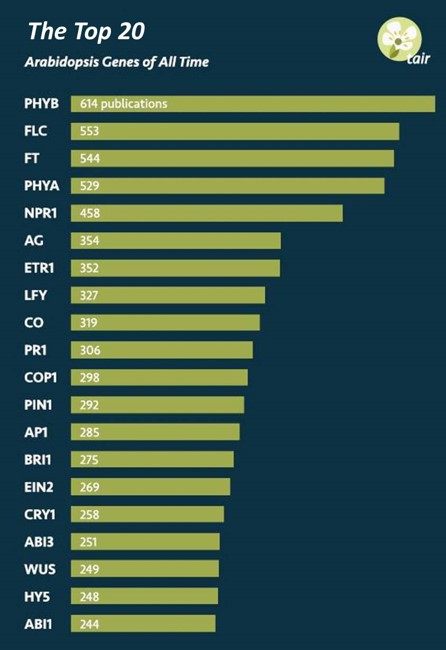
Some other stories that received lots of social media shares in Nov and Dec:
- The New York Times’ Joanne Klein wrote “How Snapdragons Beckon Bees With More Than One Color“, on a new paper on the role of small RNAs in pigmentation by Bradley et al., (showing once again that science writers are attracted to pretty flowers).
- Sánchez-León et al. described efforts to produce low-gluten, non-transgenic wheat using CRISPR/Cas9; great news for people who are gluten-sensitive.
- DNA extraction can be a time-consuming and sometimes expensive process, so we were all excited to read a method by Zou and Mason et al. which simplifies and accelerates the protocol, through absorption of the nucleic acid onto Whatman filter paper or even paper towels.
- We all know that they way we approach plant science is changing, but are we adequately incorporating those changes into the way we teach and train? This question, and possible solutions, is discussed in an important Commentary in Plant Physiology authored by many leading plant scientists: The Next Generation of Training for Arabidopsis Researchers: Bioinformatics and Quantitative Biology.
- The year draws to a close with an exciting breakthrough in Rubisco research by Aigner et al. in which the authors were able to assemble the functional enzyme in E. coli, a feat that has thwarted researchers for decades. Rubisco is the most-abundant enzyme in the world, but also notoriously inefficient. As Ars Technica reports, “We may now be able to engineer the most important lousy enzyme on the planet“.
Spotlight: Heat-resistant Non-GMO Durum Wheat (By Megan Lynch*)
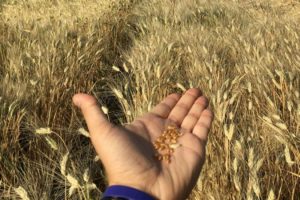 With the greenhouse effect changing which cultivars can be grown, and where and when different species can be grown, plant breeders are racing to develop varieties that can safeguard food security despite global “weirding”. As if that weren’t challenging enough, anti-GMO organizations raise fears not just in the global north but in some of the countries that will be hardest hit by climate change. Thus developing crops through marker-assisted traditional breeding is a good approach to meeting the challenge of breeding crops that can take what climate change is throwing at us, yet also avoid having a new and useful cultivar tied up in years of political wrangling.
With the greenhouse effect changing which cultivars can be grown, and where and when different species can be grown, plant breeders are racing to develop varieties that can safeguard food security despite global “weirding”. As if that weren’t challenging enough, anti-GMO organizations raise fears not just in the global north but in some of the countries that will be hardest hit by climate change. Thus developing crops through marker-assisted traditional breeding is a good approach to meeting the challenge of breeding crops that can take what climate change is throwing at us, yet also avoid having a new and useful cultivar tied up in years of political wrangling.
By identifying and using heat tolerant germplasm, the team led by Dr. Filippo Bassi & Dr. Rodomiro Ortiz bred durum wheat capable of withstanding 35 – 40 C temps. In areas where rice is grown in Mali, Mauritania, and Senegal, durum wheat could now be grown during the off-season for rice as it can not only tolerate the heat but the low night temps that prevented other staple crops from being raised. Furthermore, it’s an early variety so it can be squeezed in between the time the rice harvest finishes and rice planting starts up again. This project was recently awarded the 2017 Olam Prize for Innovation in Food Security. Read more on the International Center for Agricultural Research in the Dry Areas (ICARDA) and Food Navigator websites, and keep up to date by following the Project log on ResearchGate.
Megan Lynch* (@may_gun) has a BA in Art from UCLA and is a returning student in Biology at Pasadena Community College (Pasadena, CA, USA). She is a longtime member of California Rare Fruit Growers and hopes to go to grad school to learn fruit breeding. She’s currently studying Ceratonia siliqua and its history in California.
Without further ado, it’s time to say goodbye to 2017 and get ready to welcome in the new year. Best wishes for health, success, peace and love to all in our community and a Happy New Year!



